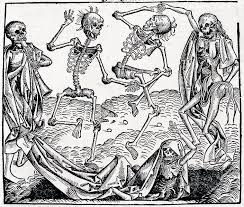Between 1340 and 1400, the Black Death spread throughout Europe, killing more than 20 million people. For hundreds of years, it was thought that fleas carried by black rats spread the deadly disease. But new research suggests that the “vermin” might not be to blame.
 Kristin Hugo of Newsweek reports a study published in the Proceedings of the National Academy of Sciences on Monday illustrates how the plague might have spread. Researchers at the University of Oslo ran computerized mathematical simulations of disease spread by human-to-human fleas and lice, by human-to-rat-to-human fleas, and by airborne pathogens.
Kristin Hugo of Newsweek reports a study published in the Proceedings of the National Academy of Sciences on Monday illustrates how the plague might have spread. Researchers at the University of Oslo ran computerized mathematical simulations of disease spread by human-to-human fleas and lice, by human-to-rat-to-human fleas, and by airborne pathogens.
The researchers compared those computerized simulations to nine examples of the actual spread of the Black Death. They found that the simulations of human-to-human models most closely resembled the actual spread patterns in the nine real studies that they investigated, indicating that rats might not have been involved at all.
A study published in 2011 supports this conclusion. Authors say that the spread of the plague was too fast for rats to have been an intermediary, and furthermore, researchers should have found more dead rats that had succumbed if they were such important disease-carriers.
 Another study in 2015 criticized the idea of rats as reservoirs of disease, claiming that the weather was too cold and rainy for rats to thrive and spread the disease widely. And an ecological review in 1986 cited a general lack of evidence for rats as the carriers of the disease.
Another study in 2015 criticized the idea of rats as reservoirs of disease, claiming that the weather was too cold and rainy for rats to thrive and spread the disease widely. And an ecological review in 1986 cited a general lack of evidence for rats as the carriers of the disease.
However, exonerating the rats is likely to prove controversial among historians, who believe that the bacteria must have at least come from rats, or some other animal carrying fleas, at some point. The researchers at Oslo admit that their computer simulations could use more data, according to National Geographic. The more data a program has, the more accurate simulations it can run.
Notably, the Black Death lost its grip when people started improving sanitation and cleaning themselves regularly, and covering sewers.


 When a bucket in one of his five bathrooms is full, he empties it in the compost pile in his backyard in rural Pennsylvania. Eventually he takes the resulting soil and spreads it over his vegetable garden as fertilizer.
When a bucket in one of his five bathrooms is full, he empties it in the compost pile in his backyard in rural Pennsylvania. Eventually he takes the resulting soil and spreads it over his vegetable garden as fertilizer..jpg) Now,
Now,